Classroom Becomes Renaissance Florence as Students Explore New Approach to Art History
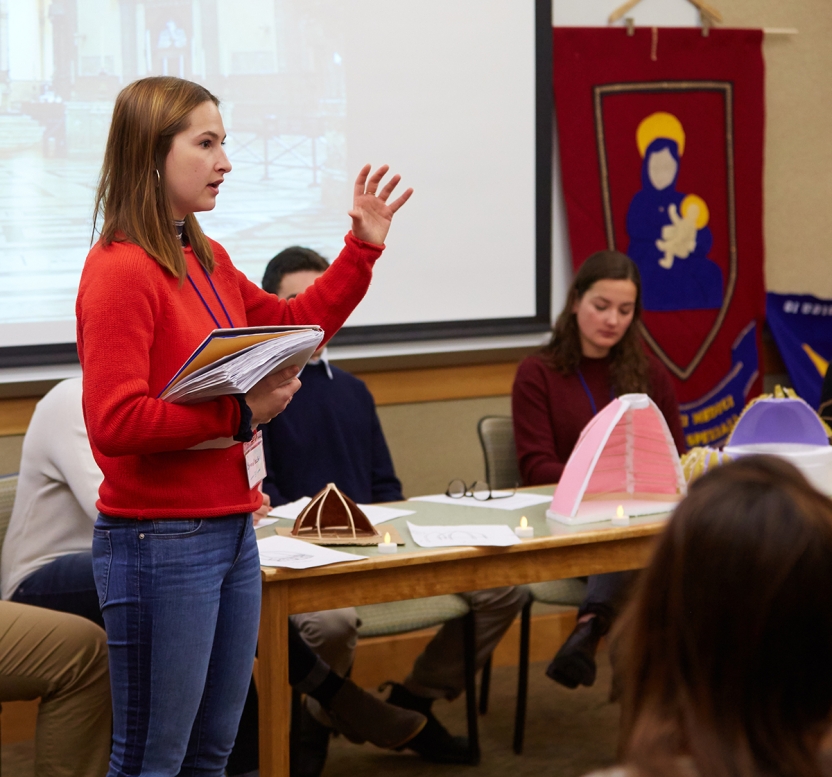
MIDDLEBURY, Vt. – It’s 7:56 on a wintry March morning, as students pour into Professor Katy Smith Abbott’s class on Italian Renaissance art, grab a donut, sit down, and open their backpacks.
“Florentines!” says senior Juan Andrade-Vera, aka Battista d’Antonio, a member of 15th-century Florence’s powerful wool guild and current foreman of the city’s star construction project, the building of the Cathedral of Santa Maria del Fiore—a project begun over 120 years earlier.
“Florentines! The final hours of the competition are upon us and it will soon be time to crown a victor!”
As d’Antonio outlines the agenda for the day, the class comes to life. Members of the wool guild’s commissioning committee occupy a prominent table up front, where they confer with each other and lord over the day’s proceedings. Others sit in groups, clustered by affiliation. Around the room hang colorful banners, each emblazoned with a guild crest. Each desk holds a “lighted” candle. A scrawled note on the whiteboard gives the date: 14 Settembre, Anno Domini 1418.
A slide on the front screen tells us we’re inside the cathedral itself, right underneath the gaping hole where one of the cathedral’s earlier architects designed a dome that no one in the medieval world knows how to build. The eight-sided opening stretches too wide, at too great a height to be crowned by any known structure or technology.
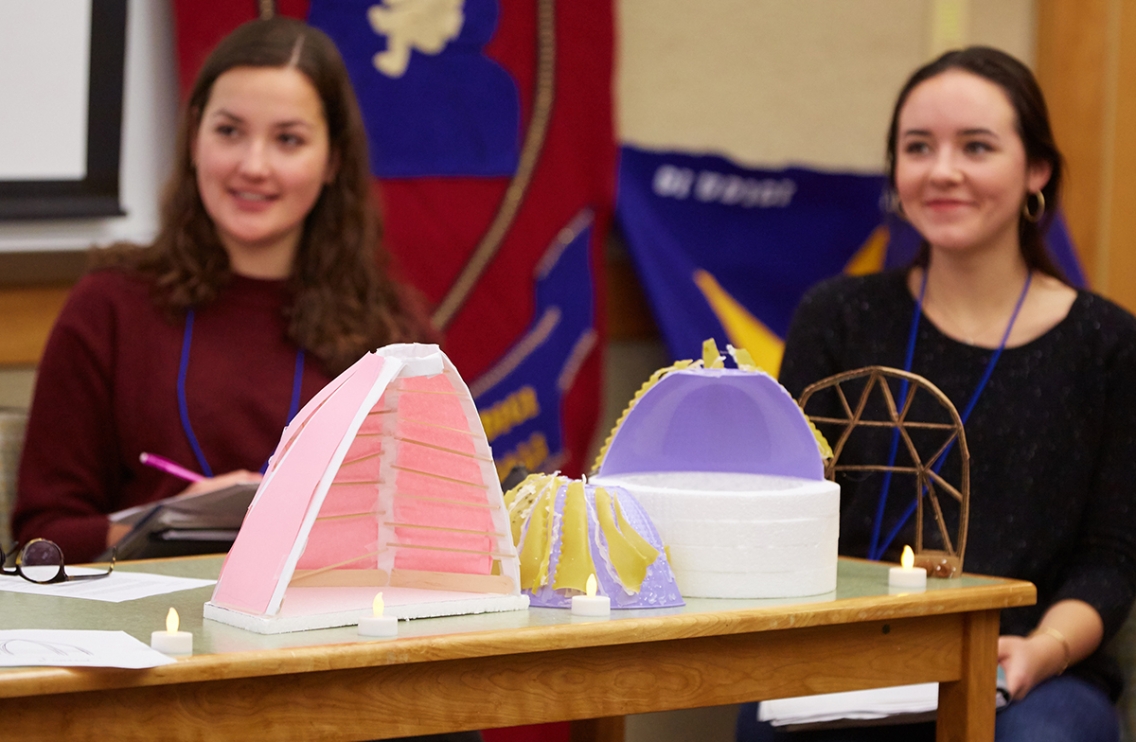
With models submitted by the Ghiberti and Pesello factions in the foreground, Tasha Kleppner ’21.5 (Simone di Francesco di Filicaia) and Claire Darrow ’22 (Schiatta Ridolfi), both judges, listen to a pitch by one of the factions.
Three factions, each led by a prominent artist of the day, are competing to build the dome.
The Renaissance is about to begin.
Smith Abbott has been teaching Middlebury students about this critical moment in art history for over 20 years. Brunelleschi’s dome, said Smith Abbott, crowned “a medieval structure with a design that didn’t belong to the past, but pointed to the future.” Even today, she said, we are still “confronted by the mystery of how he pulled it off.”
“It’s stunning, just as a sheer act of the imagination.”
This semester she’s taking an entirely new approach to the duomo competition: a historical role-playing game developed by the Barnard-based consortium Reacting to the Past (RTTP).
“I am by nature someone who tends to teach differently every time I teach the class,” said Smith Abbott, “partly for my own stimulation, partly because I’m always interested in responding to student feedback, thinking about what might make a class more dynamic, what’s a different assignment, what’s a different way of writing a paper.”
Reacting to the Past has been used on hundreds of U.S. campuses, including Brown, Smith, Carleton, and the University of Chicago. At Middlebury, it’s among a number of sophisticated role-playing pedagogies that have been employed in such departments as history, political science, and American studies.
RTTP games start with historical moments of crisis, change, or upheaval. Students are assigned roles and given group and individual goals. They collaborate, speak, and debate from the point of view of their character and seek to build alliances to achieve their goals and win.
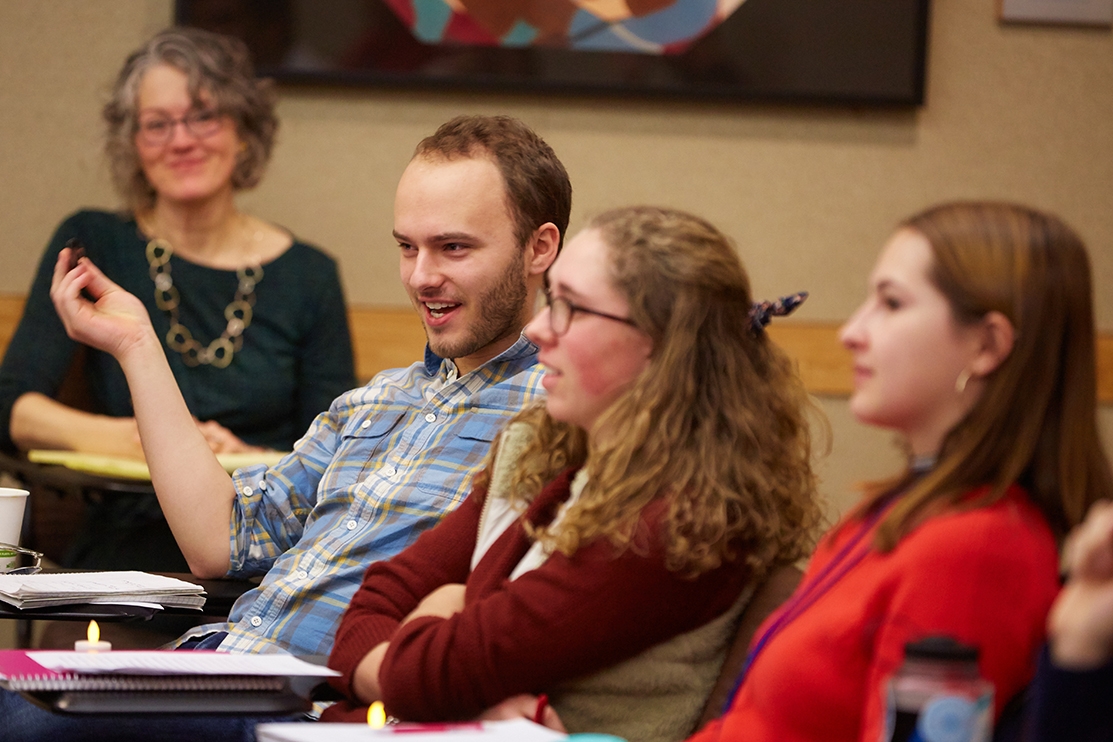
Connor Freeman ’20 (Niccolò Niccoli) challenges the Ghiberti faction about a design element, while Carlie Musto ’20 (Domenico Sandrino) and Elizabeth Warfel ’19 (Brunelleschi) listen in.
Once inside their roles, students run the class.
“I think that when the professor says to the students, ‘Hey, I’m gonna let you lead,’ then there is a certain pressure on us to really get everything we want to get out of it,” observed Andrade-Vera, an economics major and math minor.
For the duomo game, Smith Abbott’s students have become painters, goldsmiths, sculptors, stonemasons, master carpenters, scholars, merchants, and scribes. A common body of reading grounds students in the “new” humanism and in Vitruvius’s “recently” discovered books on architecture. Further reading and research is driven by one’s character. Humanists who trumpet the new writing in Italian read more Dante and Boccaccio. Cathedral foreman d’Antonio has to be able to talk about materials, machinery, and work flow, and seize an appropriate moment to demonstrate how the dome on the Roman Pantheon distributes weight—using a hula hoop. Painter Paolo Ucello must demonstrate the principles of linear perspective. Members of the three artists’ factions design and build model domes. All must forcefully articulate their character’s worldview—both in prepared speeches and extemporaneously. (Papers are written in first person, as one’s character.)
At the end, wool guild members and others vote to award the commission. This time, Ghiberti won. The game doesn’t seek to replicate historical outcomes, but instead seeks to immerse students in the competing intellectual currents of the day.
Art history senior Kate MacCary said that a key moment was just taking the plunge into this way of learning. As humanist Tommaso Parentucelli (later Pope Nicholas V), MacCary had to plan and lead a procession honoring the city’s patron saint, an event designed to transition students into the world of the game.
“It really wasn’t until halfway through my blessing that I really was able to lean in and embrace Tommaso,” said MacCary. “I suddenly came to this acceptance that we were all in this space to learn and to do this game together, and I let go of my own nervousness about being in a funny hat and speaking about God at Middlebury and just decided to embrace this role to get our class to make this jump to 1418.”
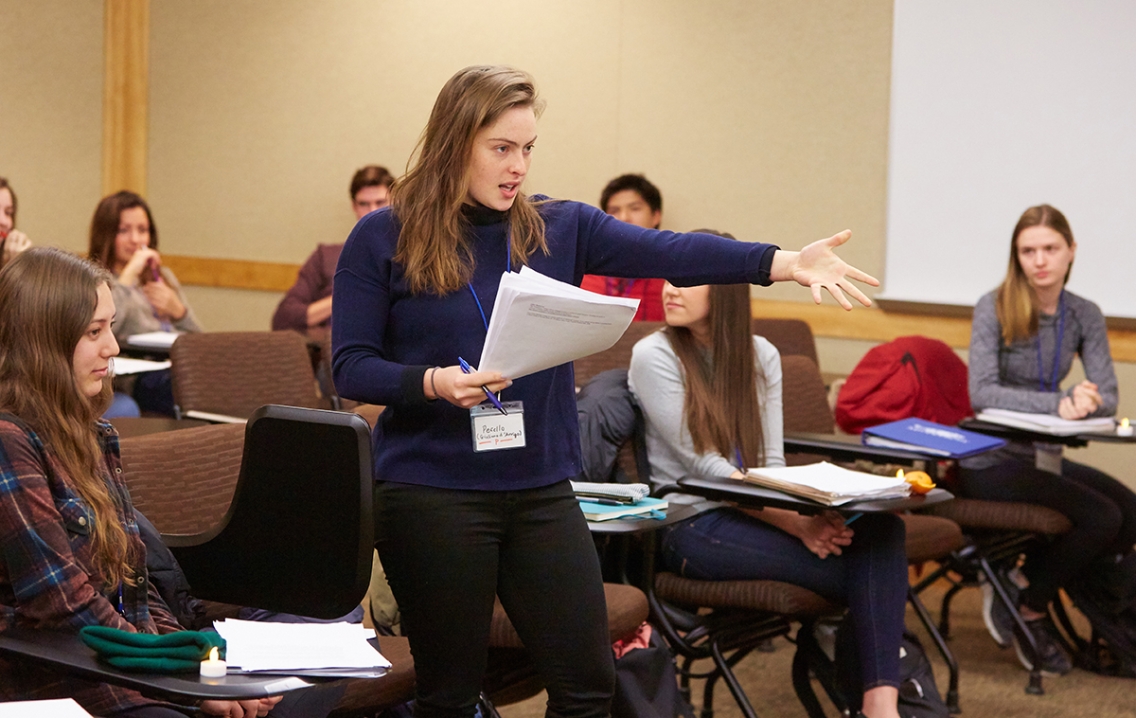
Eve Labalme ’20 (Pesello) responds to a critique by the Opera—the group judging the competition.
For religion major Connor Freeman ’20 (alias humanist Niccolò Niccoli), things started to click as the first round of characters began offering their own visions for the dome.
Humanist Giovanni da Prato had an especially challenging secret mission: buy a vote for Ghiberti.
“I wasn’t really surprised that he would want to bribe someone,” said history major Kate Criscitiello ’19, whose character wrote a still-infamous sonnet denouncing Brunelleschi as a “beast” and a “pit of ignorance.” “It seemed in character with how passionate he was about the project.”
Criscitiello consulted Smith Abbott and was given a bag of chocolate coins with which to ensnare her target. Many emails and negotiations later, she had her man. Events took a dramatic turn, however, when the bribee denounced da Prato publicly, saying: “We have amongst us, a blight that could destroy our great city. No, I do not speak of another plague, but rather an individual so perfidious that they were willing to risk our city’s honor for their personal advantage.”
By the end of that class, both briber and bribee were expelled from their respective factions—in exchanges that included spontaneously delivered Petrarchan sonnets.
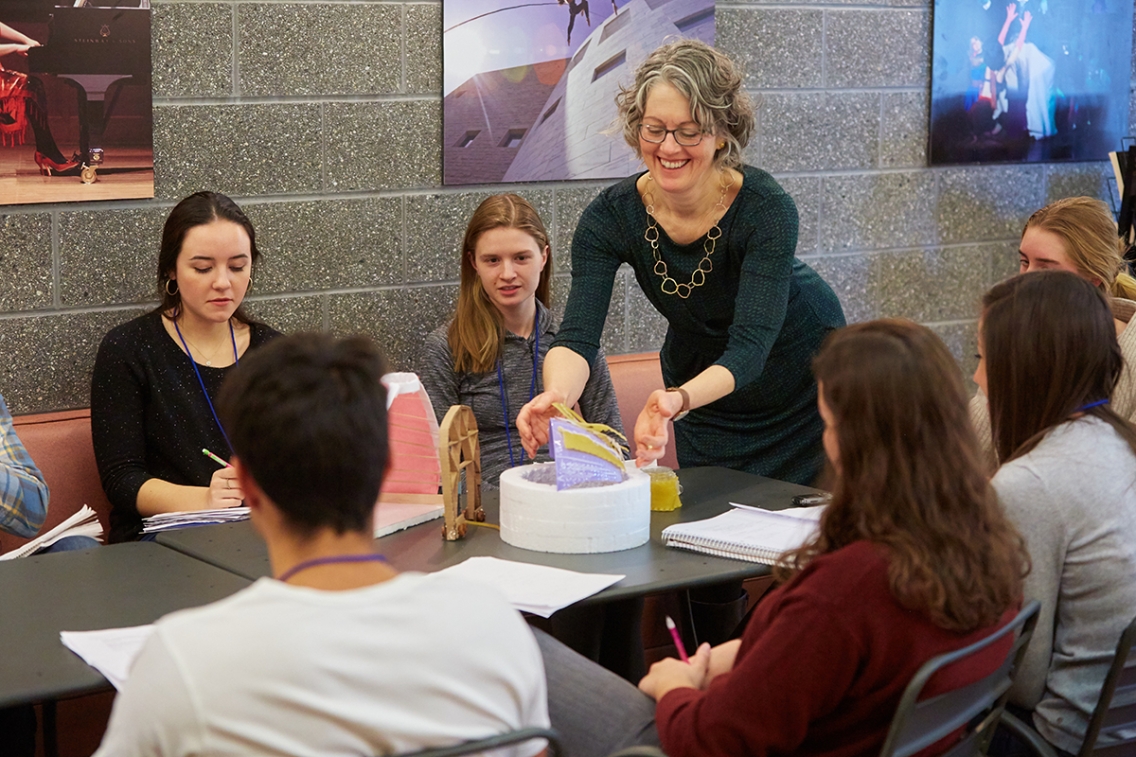
Professor Katy Smith Abbott places one of the models before the judges as they begin deliberations on the new dome proposals.
The duomo game seemed a good fit for this part of her syllabus, said Smith Abbott, because it emphasizes the social, religious, economic, and political frameworks important to Renaissance art making.
“It compels the students to internalize the fact that art making and art commissioning and art consumption were business—it was an economic enterprise, it was religious, it was about power and the position of people in society.
“So the interconnectedness of how people lived and what they thought and believed and worried about, students hear those concerns coming out right away in the voices of their fellow citizens. People care about different things in the game, based on who they are in society and what their role is and how much power they have and what their position is. All those things come out in the way they speak about their aspirations for the dome.”
The approach also drives students to grasp primary documents in particularly profound ways and to listen to each other, Smith Abbott said.
“They had to grasp ideas early and deeply … and they had to be ready to pivot and respond, refute, contradict, passionately fight for whatever they cared about when somebody else spoke as well.”
Senior art history major Elizabeth Warfel observed, “We really had to be prepared for every class. You couldn’t just skim the readings or sort of know what you were talking about. You really had to be on your feet and know what your specific role was.”
Embodying these characters also gave students a unique reflection on the value of the liberal arts, a predominant theme in Vergerius’s “On Noble Manners and Liberal Studies,” one of the core readings.
“How in order to be successful, you have to know philosophy, you have to know mathematical equations, you have to know the ways of speaking—basically what you think of as a ‘Renaissance man,’” said Andrade-Vera. “I think one of the reasons the game worked is that as Middlebury students we can really connect to that.”
By Gaen Murphree; Photos by Todd Balfour

